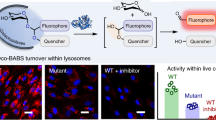Abstract
Glucocerebrosidase is a lysosomal enzyme that catalyzes the hydrolysis of glucosylceramide to form ceramide and glucose. A deficiency of lysosomal glucocerebrosidase due to genetic mutations results in Gaucher disease, in which glucosylceramide accumulates in the lysosomes of certain cell types. Although enzyme replacement therapy is currently available for the treatment of type 1 Gaucher disease, the neuronopathic forms of Gaucher disease are still not treatable. Small molecule drugs that can penetrate the blood-brain barrier, such as pharmacological chaperones and enzyme activators, are new therapeutic approaches for Gaucher disease. Enzyme assays for glucocerebrosidase are used to screen compound libraries to identify new lead compounds for drug development for the treatment of Gaucher disease. But the current assays use artificial substrates that are not physiologically relevant. We developed a glucocerebrosidase assay using the natural substrate glucosylceramide coupled to an Amplex-red enzyme reporting system. This assay is in a homogenous assay format and has been miniaturized in a 1,536-well plate format for high throughput screening. The assay sensitivity and robustness is similar to those seen with other glucocerebrosidase fluorescence assays. Therefore, this new glucocerebrosidase assay is an alternative approach for high throughput screening.




Similar content being viewed by others
References
Grabowski GA (1993) Gaucher disease. Enzymology, genetics, and treatment. Adv Hum Genet 21:377–441
Sidransky E, LaMarca ME, Ginns EI (2007) Therapy for Gaucher disease: don’t stop thinking about tomorrow. Mol Genet Metab 90(2):122–125
Smid BE, Aerts JM, Boot RG, Linthorst GE, Hollak CE (2010) Pharmacological small molecules for the treatment of lysosomal storage disorders. Expert Opin Investig Drugs 19(11):1367–1379. doi:10.1517/13543784.2010.524205
Khanna R, Benjamin ER, Pellegrino L, Schilling A, Rigat BA, Soska R, Nafar H, Ranes BE, Feng J, Lun Y, Powe AC, Palling DJ, Wustman BA, Schiffmann R, Mahuran DJ, Lockhart DJ, Valenzano KJ (2010) The pharmacological chaperone isofagomine increases the activity of the Gaucher disease L444P mutant form of beta-glucosidase. Febs J 277(7):1618–1638
Beck M (2010) Therapy for lysosomal storage disorders. IUBMB Life 62(1):33–40
Parenti G (2009) Treating lysosomal storage diseases with pharmacological chaperones: from concept to clinics. EMBO Mol Med 1(5):268–279
Parenti G, Andria G (2011) Pompe disease: from new views on pathophysiology to innovative therapeutic strategies. Curr Pharm Biotechnol 12(6):902–915
Rozenfeld P, Neumann PM (2011) Treatment of fabry disease: current and emerging strategies. Curr Pharm Biotechnol 12(6):916–922
Pastores GM, Giraldo P, Cherin P, Mehta A (2009) Goal-oriented therapy with miglustat in Gaucher disease. Curr Med Res Opin 25(1):23–37
Owada M, Sakiyama T, Kitagawa T (1977) Neuropathic Gaucher’s disease with normal 4-methylumbelliferyl-beta-glucosidase activity in the liver. Pediatr Res 11(5):641–646
Broadhead DM, Butterworth J (1977) The diagnosis of Gaucher’s disease in liver using 4-methylumbelliferyl-beta-D-glucopyranoside. Clin Chim Acta 75(1):155–161
Urban DJ, Zheng W, Goker-Alpan O, Jadhav A, Lamarca ME, Inglese J, Sidransky E, Austin CP (2008) Optimization and validation of two miniaturized glucocerebrosidase enzyme assays for high throughput screening. Comb Chem High Throughput Screen 11(10):817–824
Hays WS, Wheeler DE, Eghtesad B, Glew RH, Johnston DE (1998) Expression of cytosolic beta-glucosidase in guinea pig liver cells. Hepatology 28(1):156–163
Zhu BC, Henderson G, Laine RA (2005) Screening method for inhibitors against formosan subterranean termite beta-glucosidases in vivo. J Econ Entomol 98(1):41–46
van Es HH, Veldwijk M, Havenga M, Valerio D (1997) A flow cytometric assay for lysosomal glucocerebrosidase. Anal Biochem 247(2):268–271
Ben-Yoseph Y, Nadler HL (1978) Pitfalls in the use of artificial substrates for the diagnosis of Gaucher’s disease. J Clin Pathol 31(11):1091–1093
Wenger D, Olsen GC (1981) Heterogeneity in Gaucher disease. In: Callahan JW, Lowden JA (eds) Lysosomes and lysosomal storage diseases. Raven, New York, pp 157–171
Choy FY, Davidson RG (1980) Gaucher disease. III. Substrate specificity of glucocerebrosidase and the use of nonlabeled natural substrates for the investigation of patients. Am J Hum Genet 32(5):670–680
Hayashi Y, Zama K, Abe E, Okino N, Inoue T, Ohno K, Ito M (2008) A sensitive and reproducible fluorescent-based HPLC assay to measure the activity of acid as well as neutral beta-glucocerebrosidases. Anal Biochem 383(1):122–129
Mazura P, Fohlerova R, Brzobohaty B, Kiran NS, Janda L (2006) A new, sensitive method for enzyme kinetic studies of scarce glucosides. J Biochem Biophys Methods 68(1):55–63
Zhu Y, Jiang JL, Gumlaw NK, Zhang J, Bercury SD, Ziegler RJ, Lee K, Kudo M, Canfield WM, Edmunds T, Jiang C, Mattaliano RJ, Cheng SH (2009) Glycoengineered acid alpha-glucosidase with improved efficacy at correcting the metabolic aberrations and motor function deficits in a mouse model of Pompe disease. Mol Ther 17(6):954–963
Marugan JJ, Zheng W, Motabar O, Southall N, Goldin E, Sidransky E, Aungst RA, Liu K, Sadhukhan SK, Austin CP (2010) Evaluation of 2-thioxo-2,3,5,6,7,8-hexahydropyrimido[4,5-d]pyrimidin-4(1H)-one analogues as GAA activators. Eur J Med Chem 45(5):1880–1897
Motabar O, Liu K, Southall N, Marugan JJ, Goldin E, Sidransky E, Zheng W (2010) High throughput screening for inhibitors of alpha-galactosidase. Curr Chem Genomics 4:67–73
Peters SP, Coyle P, Glew RH (1976) Differentiation of beta-glucocerebrosidase from beta-glucosidase in human tissues using sodium taurocholate. Arch Biochem Biophys 175(2):569–582
Acknowledgments
This research was supported by the Molecular Libraries Initiative of the NIH Roadmap for Medical Research and the Intramural Research Programs of the National Human Genome Research Institute and the National Institutes of Health.
Author information
Authors and Affiliations
Corresponding author
Rights and permissions
About this article
Cite this article
Motabar, O., Goldin, E., Leister, W. et al. A high throughput glucocerebrosidase assay using the natural substrate glucosylceramide. Anal Bioanal Chem 402, 731–739 (2012). https://doi.org/10.1007/s00216-011-5496-z
Received:
Revised:
Accepted:
Published:
Issue Date:
DOI: https://doi.org/10.1007/s00216-011-5496-z




